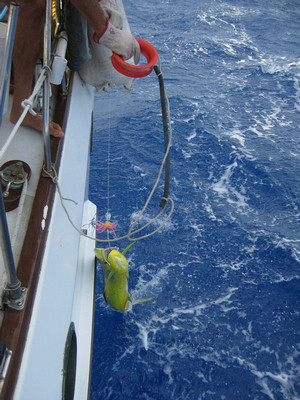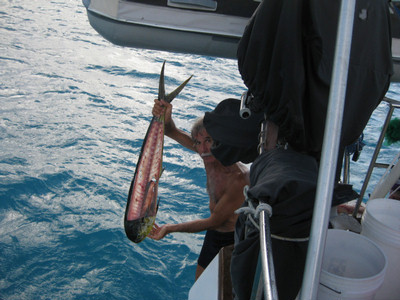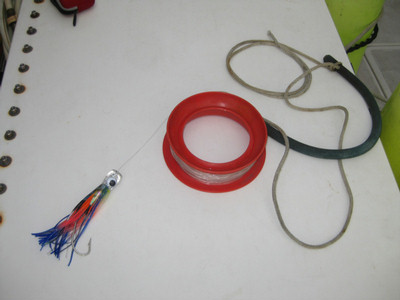We are at the atoll of Tahanea, in the Tuamotus of French Polynesia. Around here, your anchoring conditions are
(1) Solid coral bottom
(2) Sand with a lot of coral heads
(3) Sand with a few coral heads (rare)
Due to being chased around by weather, we are currently anchoring in sand with a lot of coral heads. The water depth is usually 35-50 feet, and the coral heads are 4-5' off the bottom, and scattered on the bottom at about every 6-10 feet or so, with sand in between. This is a perfect setup to badly wrap your chain, damaging the coral and endangering your boat. If your chain gets wrapped close to the boat, you no longer have the 'catenary' of chain that provides a shock absorber when the wind blows or the waves get big. You can snap the chain or break bow rollers and windlasses in this situation.
On the advice of another cruiser (also fairly new to cruising this area), we bouyed our chain in 2 places to make it hang in the water above the coral heads. This turned out to be a pretty neat arrangement. Using readily available 'pearl farm' bouys, which can be found on any windward beach, we tied 2 together with a short line, and tied that line thru the anchor chain, to make one 'bouy'. The amount of flotation required depends on how heavy your chain is and how far apart you place the bouys. We found that 2 pearl farm bouys is just perfect to suspend 25-50' of our 3/8 HT chain.
Our friend recommended one bouy 1.5x the water depth from the anchor, and another 2.5x the water depth, with enough floatation to hold your chain up. You first put all your normal scope out and get the anchor set well, then pull up carefully to add the bouys in the right place.
After deploying ours as recommended (using a total of 4 pearl bouys in 2 sets of 2 bouys), I snorkeled to check the anchor and the chain. It looked pretty slick. The anchor was well set, the chain was hanging eerily over the coral heads and we were ready for the expected windshift, no problem.
Well, the middle of the night brought almost a 180 degree shift, and 25-30 knot winds in gusts. The fetch across the 10 miles of coral lagoon caused 4-5 foot waves in the anchorage, and our bow was pitching heavily, with a few waves breaking over the bow. Dave actually sent me below in the middle of our anchor drill, to batten all the hatches as if we were at sea!.
For the first time in a long time, we actually dragged anchor. Over a period of several hours and several squalls, we first held OK, then came loose from one coral head and held at another position, but then in a particularly bad squall (when a neighboring boat also dragged), we dragged our big 88-lb Delta about a hundred feet through the coral heads before it finally re-set itself.
We ended up in 10' of water (after having initially anchored in 35 feet), on a lee shore in a blow, with an isolated coral head within about 2 feet of our keel (unbeknownst to us at the time), and the reef right behind us around 100'. It was rainy and dark as hell, so we couldn't actually see the reef behind us, but we knew it was there, and our chart plotter told us we were 'on the coral' already, so we knew it was very close.
Fortunately, with the shallower water, our 'scope' ended up about 10:1, our anchor had found a good pocket of sand, and we held finally pretty well. We were damned lucky. We spent the last 4 hours of darkness with the engine on (in neutral, but ready to go) and one of us at the helm, watching the GPS and ready at the throttle if we needed to. We counted the minutes to 'first light' so we could safely assess the situation and decide how to extricate ourselves.
We considered, but rejected, trying to re-anchor in the night. But, not knowing how our chain might be wrapped, and the complexity of getting the snubber and the bouys aboard as we're pulling in the chain, and the 25 knot gusts that would make low-speed maneuvering almost impossible, we opted to sit tight and hope our anchor would continue to hold. Fortunately, it did.
At dawn, holey moley, there was the reef close behind us!
I jumped in the water to assess the situation, and saw the one coral head a few feet under our keel as we swung back and forth. By then the wind had eased some, and gone back East a little, giving us a little protection from the waves. We turned out not to be too badly wrapped, the bouys having done the job well. To solve the problem of bouy retrieval while pulling in the chain, I took a sharp knife out and cut the bouys free.
As to why our 'never drags' Delta did drag, Dave suspects that the bouy close to the anchor was set too close, and interfered with our Delta's holding/resetting power under extreme conditions. We probably were also not set in really deep sand.
So when we re-anchored, we opted to go with only one (set of) bouys, placed about 1.5x the water depth from the BOW (vs the anchor). This leaves about 30-40' of chain laying on the bottom, where it might wrap, but also provides the correct angle of pull for the anchor. But the last 100' of chain is neatly suspended about 10' above the tops of the coral heads. If the wind switches, we would probably wrap the first 50', but we always have more chain we can let out (and another set of bouys we can deploy, if necessary).
To facilitate bouy attachment and retrieval, Dave found a snap shackle that fits the chain, so he now has 2 bouys tied together with a 3-4' line, with the shackle tied in the middle. He can easily snap on and remove a pair of bouys in a few seconds, as the chain is coming in or going out. The shackle only has to hold a few hundred pounds of chain, in water, so it doesn't need to be super-hefty. Caribiners or something similar might be scrounged out of your spare hardware box to do the trick. We have the second set of bouys ready to attach another 50' down the chain, should we need to let out more scope.
We'll let you know how the whole thing works out in the end.
-----
At 5/14/2010 8:14 PM (utc) our position was 16°51.06'S 144°41.55'W
----------
radio email processed by SailMail
for information see: http://www.sailmail.com


